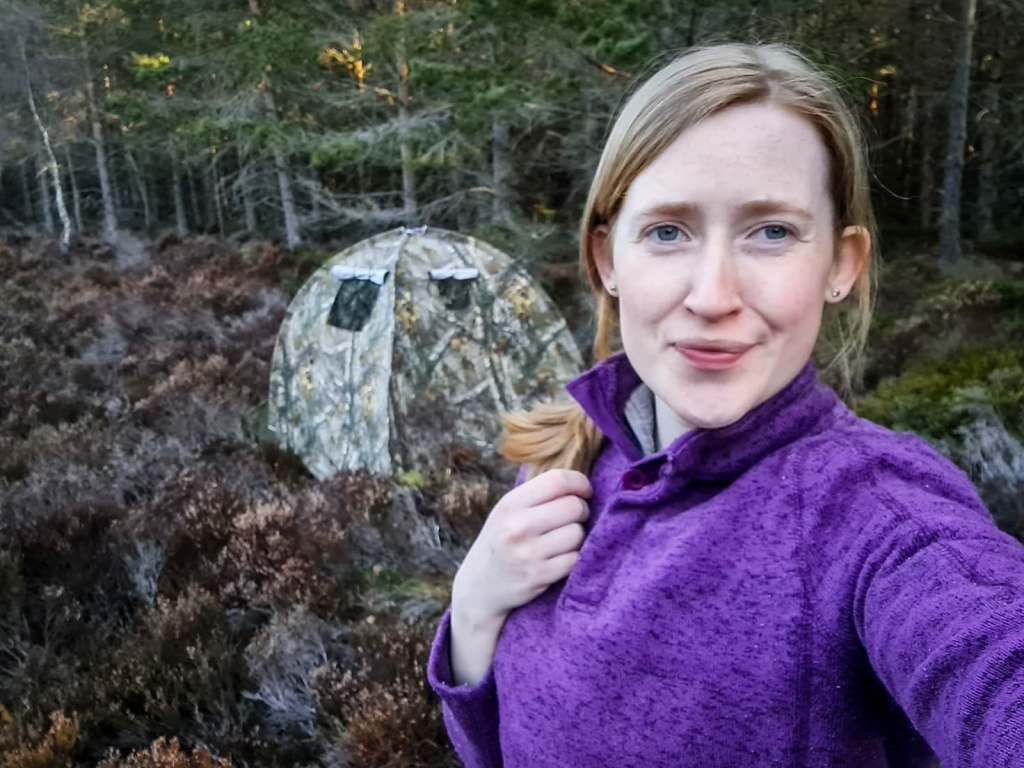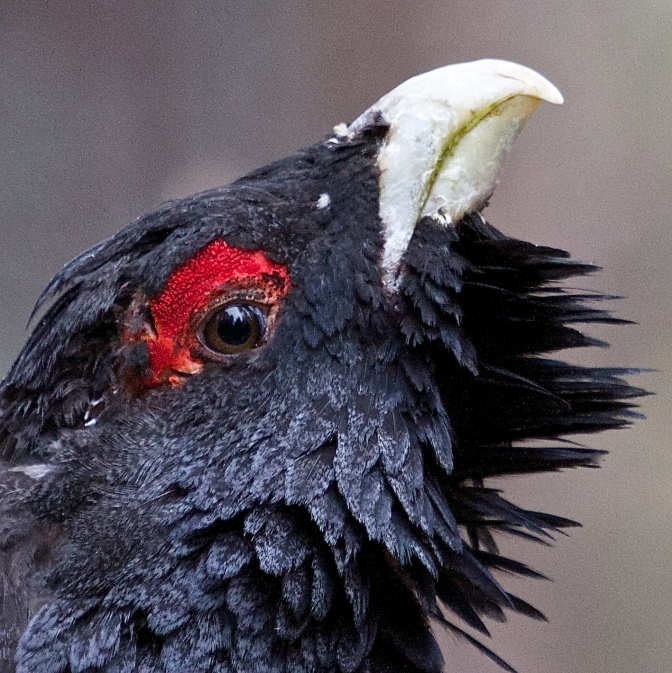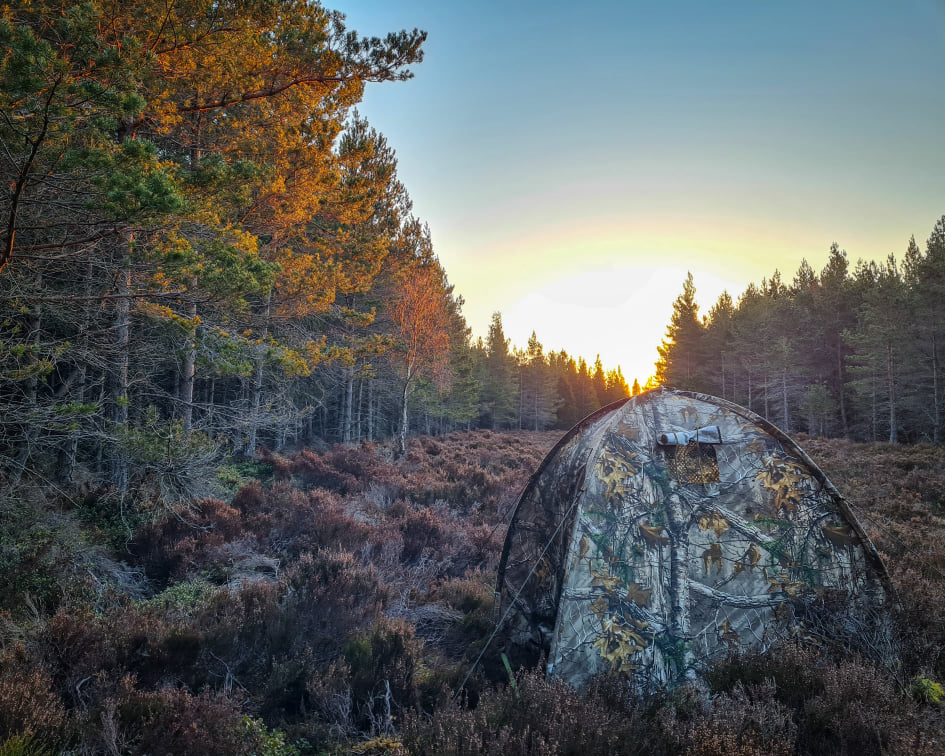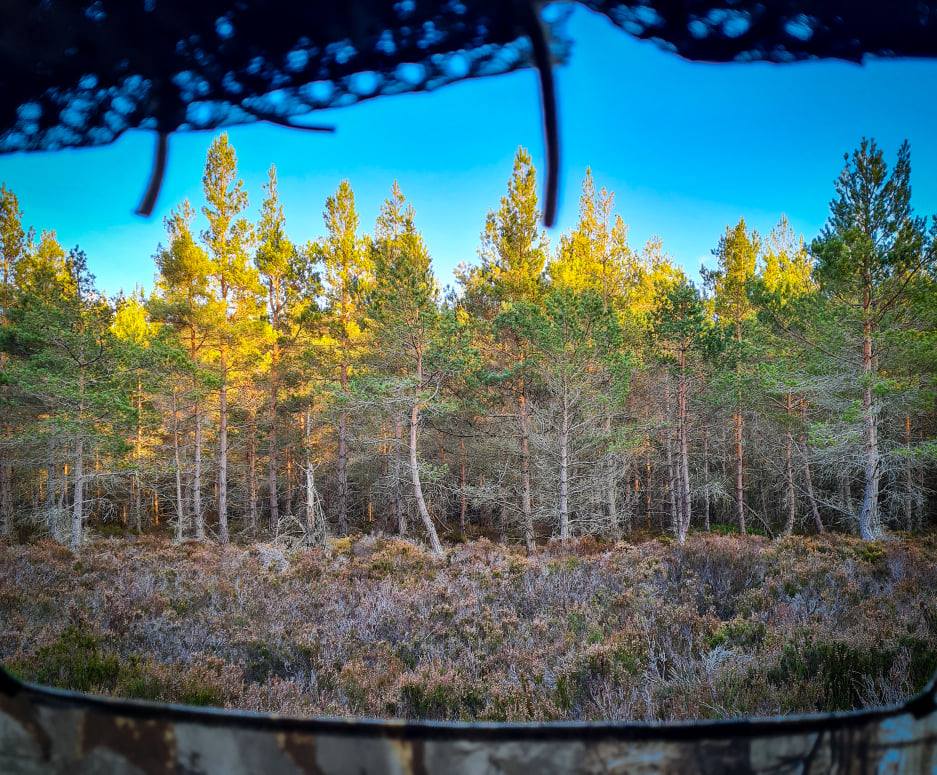What I can’t face is the thought of walking through Highland forests, knowing that these majestic birds are not silently watching from the canopy. This is why I cannot let these birds go. As, more than anything else, they belong here, and they deserve to be saved.
Molly Doubleday

Its pitch black in the forest. At 4am in April, sunrise is still far off. It’s also chilly. I huddle deeper into my sleeping bag. Careful not to make a sound. My head is down. My eyes are heavy with exhaustion. Yet my ears are alert. Straining to listen in the silence. This morning, I am rewarded. Finally, I hear the quiet, yet unmistakable popping, breaking through the forest. This call is as ancient as the forest itself. It has begun. I release a silent breath of relief, square my shoulders, and start to concentrate. Keeping everything crossed for a good count this morning.
When I was 13, I had absolutely no intention of counting capercaillie for a living. Already set on a career in conservation, elephants were my species of choice. After watching a documentary based in an elephant orphanage, I made the decision that my future career must involve baby elephant cuddles. With this aim in mind, I started researching to find out how one actually becomes a conservationist.
You do not need to go to university to work in conservation, but this was the choice I made. I always enjoyed academia so couldn’t wait to bury my nose in more books. I completed a BSc in Conservation Biology and then a MSc in Endangered Species Recovery and Conservation. I soon learnt that university was not going to be enough to land a role in the incredibly competitive conservation sector. I needed real industry experience.
Hence my numerous voluntary placements. As my family is based on the Isle of Arran, much of these placements were in Scotland. I found myself drawn to the Scottish Highlands again and again. Like a moth to an unbelievably beautiful flame. After graduating, I made the somewhat questionable decision to turn down a paid role interview, that was going to be based in south England, to take an unpaid internship at RSPB Abernethy reserve, located in the heart of the Highlands. A winter that would change the course of my life.

Capercaillie were obviously on my list of ‘must-see’ creatures when working at Abernethy. I didn’t put much thought into it, as I often class myself as a ‘lazy birder’, preferring to wait for species to cross my path when the time is right. I couldn’t predict the impact this first sighting would have. It was so sudden. Rounding the corner in my trusty RSPB land rover, they were just there. Three capercaillie on the track. A male and two females. After a moment’s hesitation, the forest echoed with their sudden wingbeats as they retreated into the forest. The male, however, didn’t go far. He sat and watched me from his perch. I held my breath as I slowly turned to reach for my binoculars. However, when I turned back, he was gone. Melted into the forest without a sound. Leaving me to wonder whether I imagined it all. Now I understood what all the fuss was about….

I am grateful for my time at Abernethy, as it equipped me with the relevant experience so that I successfully bagged the role of ‘Capercaillie Assistant’ and, 6 months later, progressed to my current role of ‘Capercaillie Advisory Officer’. I have been in this role for 3 years now, so am highly aware of the challenge we are facing to save these birds.
Capercaillie are in a perilous position in Scotland. The last National Survey indicated that we only have approximately 1000 birds left, but it could now be even fewer. What has caused this decline in numbers? Well, the threats to capercaillie are numerous and complex. These include a reduction and fragmentation of suitable habitat, weather factors/climate change (especially wet Junes when chicks are small), collisions with unmarked deer fences, predation by generalist predators and human disturbance. In order to save capercaillie, we must confront all of these threats, and we need to do this now.
So, what does an average day for a Capercaillie Advisory Officer look like? The short answer is, there isn’t one. However, as my title suggests, a key part of my role is to give advice. I use my expertise to advise land owners on how to manage their land for capercaillie, give suggestions to statutory organisations on how to mitigate negative impacts of developments or raise awareness and understanding of how the general public can help these birds. Essentially, my role is to empower others, as I cannot do this alone.
I also lead on the monitoring of this bird across Scotland. Hence the introduction of me huddling in a hide at 4am, listening for capercaillie. This is part of our lek counts, where experienced counters are coordinated across Scotland, to record the number of males attending leks, giving us a valuable insight into how the birds are doing. This can be the most exciting but also most challenging 2 weeks of my year. Not all mornings have happy endings. In too many forests, the darkness remains silent.


Why do we bother? Does it really matter if we no longer have capercaillie in Scotland? I hear these questions a lot in my role, and they are valid. A huge amount of time and money has been spent on this species over the last 30 years. Yet the birds still continue to decline.
Capercaillie are not a keystone species. This means that, realistically, if capercaillie disappeared from Scotland, the ecosystem would still continue to function perfectly well. So, what is the point of spending yet more money on them? I have professional answers to these questions. I could highlight that capercaillie act as a ‘flagship’ species. This means that they can be effectively used to draw support for conservation measures, that will also benefit other species. Conserving native forests is essential for numerous species in Scotland, that are likely far more important to the ecosystem, but rarely get dedicated financial support.
It is also important to be aware of capercaillie in a global context. Although this species isn’t endangered worldwide, they are declining. Once you start digging into the data, the pattern of threats and subsequent declines becomes all too familiar. This context makes our apparently insignificant population all the more important.
These are good answers and the ones I give again and again in my role. These are the ones that bring the money in. However, what I don’t say, is that since that first moment when capercaillie crossed my path, they have captivated me. What I don’t communicate are the tears of relief that fill my tired eyes when I finally hear this call echoing through the dawn forest. What I can’t face is the thought of walking through Highland forests, knowing that these majestic birds are not silently watching from the canopy. This is why I cannot let these birds go. As, more than anything else, they belong here, and they deserve to be saved.
So no, I still haven’t had the experience of spooning a baby elephant. Perhaps I never will. But the fire of that early conservationist is still with me. There was a reason capercaillie were on that track on that snowy morning at Abernethy. Our destinies became intertwined in that moment. I have flushed many a capercaillie in my time, but never again have birds paused, as that male did. He needed help and it is my privilege to do everything I can to give them just that. If I have my way, these ‘horse of the woods’ will haunt the Highlands for many years to come. Just as they should.
A fascinating account, Molly. Thank you. I had no idea that capercaillie were so threatened. May your count increase!
LikeLiked by 1 person
Reblogged this on jackyp599's Blog and commented:
A really interesting piece about Capercaillie. I’ve yet to see one on my highland trips and this has inspired me to quietly keep looking!
LikeLike